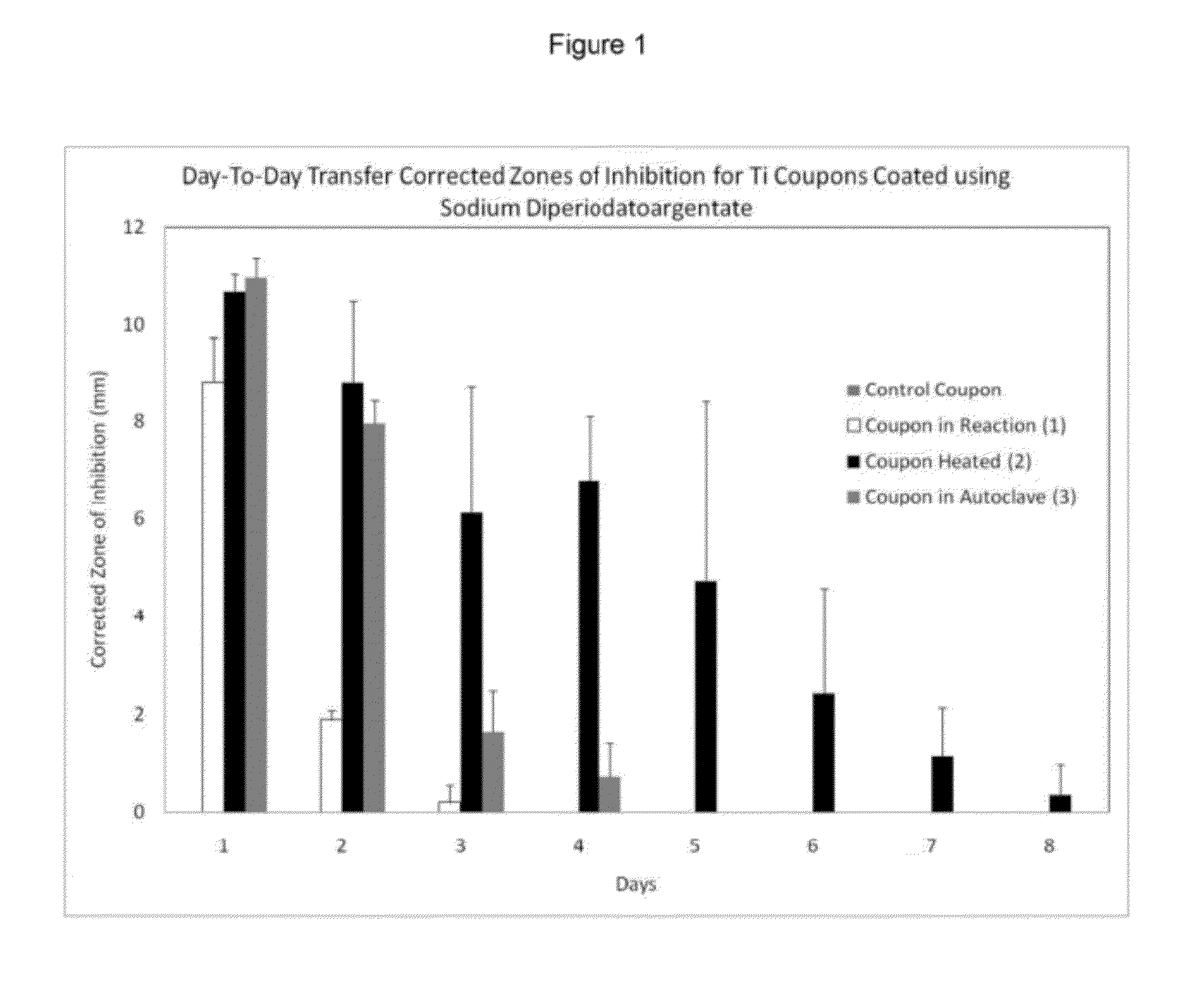Silver Iodate Compounds Having Antimicrobial Properties
a technology of silver iodate and compounds, applied in the field of silver iodate compounds, can solve the problems of lack of coating uniformity, poor adhesion, and noncontact deposition coating techniques, and achieve the effect of treating and/or eradicating biofilms
- Summary
- Abstract
- Description
- Claims
- Application Information
AI Technical Summary
Problems solved by technology
Method used
Image
Examples
example 1
Coating Grade 2 Titanium with Ag5IO6 during reaction to make sodium diperiodatoargentate
[0096]Titanium (Ti) cords were coated with pentasilver hexaoxoiodate by placing them in the vessel while the above reaction was performed, as described briefly below:[0097]1. 250 mL ddH2O was heated to 50° C.[0098]2. Ti cords were washed in ddH2O.[0099]3. While stirring at a medium rate, 5.0 g KOH was dissolved in solution, followed by 6.0 g of K2S2O8 (ensuring all had dissolved), followed by 1.6 g of KIO4.[0100]4. Ti cords were added to the solution.[0101]5. The solution was heated to 80° C.[0102]6. The stirring rate was increased to a high rate.[0103]7. In a separate flask, AgNO3 was dissolved in 150 mL of ddH2O and heated to 60° C.[0104]8. This AgNO3 solution was added to the persulfate / periodate solution at a rate of 0.3 mL / min.[0105]9. Any color changes, gas or solid formation was recorded.[0106]10. The solution was removed from the hot plate once all the AgNO3 was added.[0107]11. The soluti...
example 2
Other Hydrothermal Methods for Coating Grade 2 Ti
[0109]Various hydrothermal reaction methods have been developed with the starting component being sodium diperiodatoargentate in distilled water, which was reacted to coat Grade 2 (commercially pure) titanium with Ag5IO6:[0110]1) Titanium cord was placed in the reaction vessel during the formation of sodium diperiodatoargentate (reaction time approximately 3 hours—see Example 1 for details).[0111]2) Titanium cord was placed in a concentrated solution (e.g. 5000 ppm) of sodium diperiodatoargentate, which was then heated at 80° C. in an open vessel for 3 hours.[0112]3) Titanium cord was placed in a concentrated solution (e.g. 5000 ppm) of sodium diperiodatoargentate, which was then autoclaved using a liquid cycle (temperature=121° C., pressure=15 psig, 20 minutes).
example 3
Bacteriostatic Activity of Coated Grade 2 Ti
[0113]Titanium (Ti) cords coated using all three methods shown in Example 2 were tested for bacteriostatic longevity using day-to-day transfer corrected zone of inhibition (CZOI) assays. The Ti cords were pressed into agar on which a lawn of Pseudomonas aeruginosa had been spread and after incubation overnight, the zone of inhibition created was measured in perpendicular directions and the Ti cords were transferred to fresh agar plates for another challenge. This was repeated until the Ti cords no longer generated any zones of inhibition.
[0114]The results are shown graphically in FIG. 1.
[0115]These data show that the longevity of method (1) was 3 days, the longevity of method (2) was 8 days, and the longevity of method (3) was 4 days, indicating that the method of heating at 80° C. for 3 h was likely the most effective coating method in terms of biological activity. The uncoated Ti cords did not generate any zone of inhibition, even on the...
PUM
| Property | Measurement | Unit |
|---|---|---|
| temperature | aaaaa | aaaaa |
| temperature | aaaaa | aaaaa |
| temperature | aaaaa | aaaaa |
Abstract
Description
Claims
Application Information
 Login to View More
Login to View More - R&D
- Intellectual Property
- Life Sciences
- Materials
- Tech Scout
- Unparalleled Data Quality
- Higher Quality Content
- 60% Fewer Hallucinations
Browse by: Latest US Patents, China's latest patents, Technical Efficacy Thesaurus, Application Domain, Technology Topic, Popular Technical Reports.
© 2025 PatSnap. All rights reserved.Legal|Privacy policy|Modern Slavery Act Transparency Statement|Sitemap|About US| Contact US: help@patsnap.com

